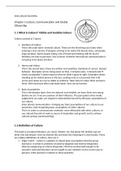Intercultural Sensitivity
Chapter 1 Culture, Communication and Global
Citizenship
1.1 What is Culture? Visible and Invisible Culture
Culture consists of 3 layers:
1. Artefacts of Culture
This is the outer layer/ material culture. These are the first thing you notice when
entering a new country. (Foreigner arriving to NL notice the bicycle lanes, tall people,
large windows, Dutch people eating a lot of bread and drinking milk for lunch.)
Artefacts are easy to perceive, nice to know. However intercultural communication is
not going to be about artefacts.
2. Norms and Values
This is the second layer, these are written and unwritten standards of correct, desired
behavior. (Examples norms: being exact on time, 3 minutes early, 3 minuets late
what is acceptable?) values express what we think is good or right. (Examples values:
standing up for elderly person in the bus, sending note to a classmate that is ill)
norms and values are not as visible as artefacts. Takes time to notice them and learn
them. With necessary effort and observation, they can be learned.
3. Basic Assumptions
This is the deepest layer, they are abstract and invisible, we learn them very young
(before we are 7) we are unaware of their influence. The perception of the world,
judgements we make, are shaped or distorted(vervormd) by the basic assumptions of
our culture.
Intercultural communication = bringing our basic assumptions of our culture to our
awareness. And recognizing basic assumptions of other cultures.
This is in order to communicate creatively, more effectually with other cultures, to
use cultural diversity at work as source of inspiration and growth, and to achieve
cultural synergy (samenwerking)
1.2 Definition of Culture
This book is not about literature, art, music, theater, etc. But about the familiar way we
think, feel and behave. How we learned this and share the meaning of it with society. There
are endless definitions of culture, here are 4.
1. Edgar Schein – culture is a pattern of shared basic assumptions that the group
learned as it solved its problems of external adaption and internal integration.
(Externe aanpassing en interne integratie.) That has worked well enough to be
considers valid and therefore can be taught to new members as the correct way to
perceive, think and feel in relation to those problems.
, 2. Mijnd Huijser – culture is a group’s set of shared norms and values expressed in the
behavior of the group’s members.
3. Fons Trompenaars – culture is the way in which a group of people solves problems.
4. Geert Hofstede – culture is the collective programming of the human mind, which
distinguishes the members of one group or category of people from another.
1.3 Cultural Programming
Culture is learned through upbringing, socialization, norms, values and perception.
Upbringing: a lot of programming of culture starts here, as a child there are so many
things that are repeated and drilled so often that you end up thinking that it is
normal (shaking hands)
Socialization: we learn a lot of things by interacting with others (handshake, you learn
through socialization just how firm a desirable (wenselijk) handshake is, the right
smile, the right amount of eye contact.)
Norms and values: values showing respect for older people. Normgive up your
seat to an elderly person.
Perception: just by looking around us we make conscious or unconscious choices
about how we want to behave.
Regardless of culture, each person is a unique individual and makes choices, for example to
deviate from cultural group norms. There are 3 levels of programming:
Individual
Cultural
Human Nature
1.4 Culture and subcultures
Collective indicates the group or subgroups we belong to, it doesn’t mean that the whole
country in one big group or shares one set of cultural patterns on the contrary, there are a
lot of subgroups/ subcultures we belong to.
List of possible subcultures:
- A continent
- A country
- Ethnic
- Regional
- Urban or rural culture (Stedelijke of landelijke cultuur)
- Religion
- Social class
- Gender
- Age






